Essay on Workforce Diversity and Its Organizational Implications
VerifiedAdded on 2019/11/19
|12
|2149
|185
Essay
AI Summary
This essay delves into the multifaceted concept of workforce diversity, defining it as the collaboration of individuals from varied cultural and traditional backgrounds. It highlights the significance of diversity through increased productivity, creativity, and employee loyalty. The essay explores both primary and secondary dimensions of diversity, citing examples such as age, gender, and cultural beliefs. It discusses the benefits of diversity management, including strengthened cultural values and improved customer satisfaction, while also acknowledging challenges like workplace discrimination and language barriers. The essay examines the history of diversity planning, from equal employment opportunities to global diversity, and analyzes the Australian context, including challenges faced by minority groups. It further explores the implications of workforce diversity through Hofstede's cultural dimensions, discussing how cultural differences affect individual performance. Finally, the essay concludes by recommending strategies to mitigate the challenges of diversity, such as promoting two-way communication and establishing strict anti-discrimination policies.
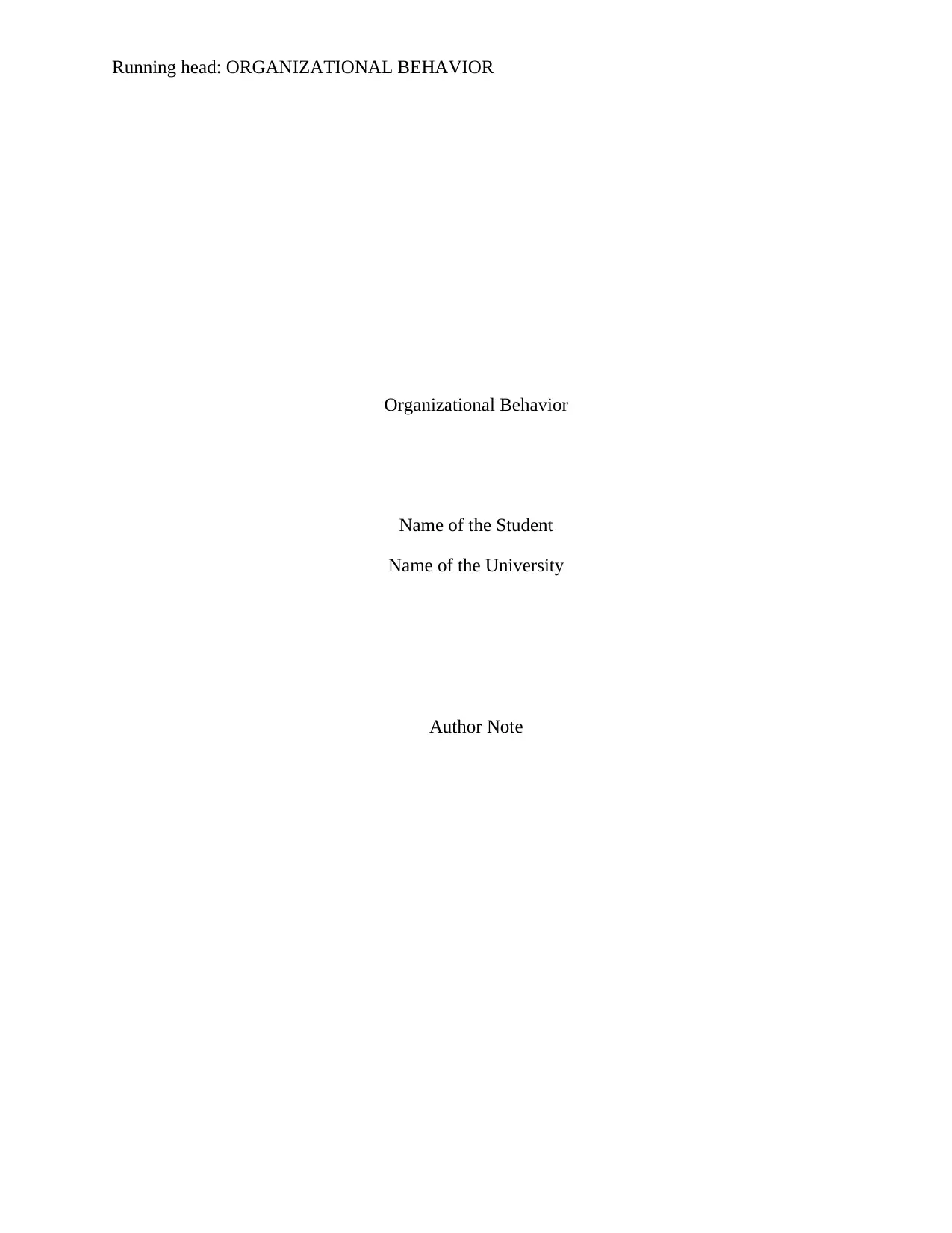
Running head: ORGANIZATIONAL BEHAVIOR
Organizational Behavior
Name of the Student
Name of the University
Author Note
Organizational Behavior
Name of the Student
Name of the University
Author Note
Paraphrase This Document
Need a fresh take? Get an instant paraphrase of this document with our AI Paraphraser
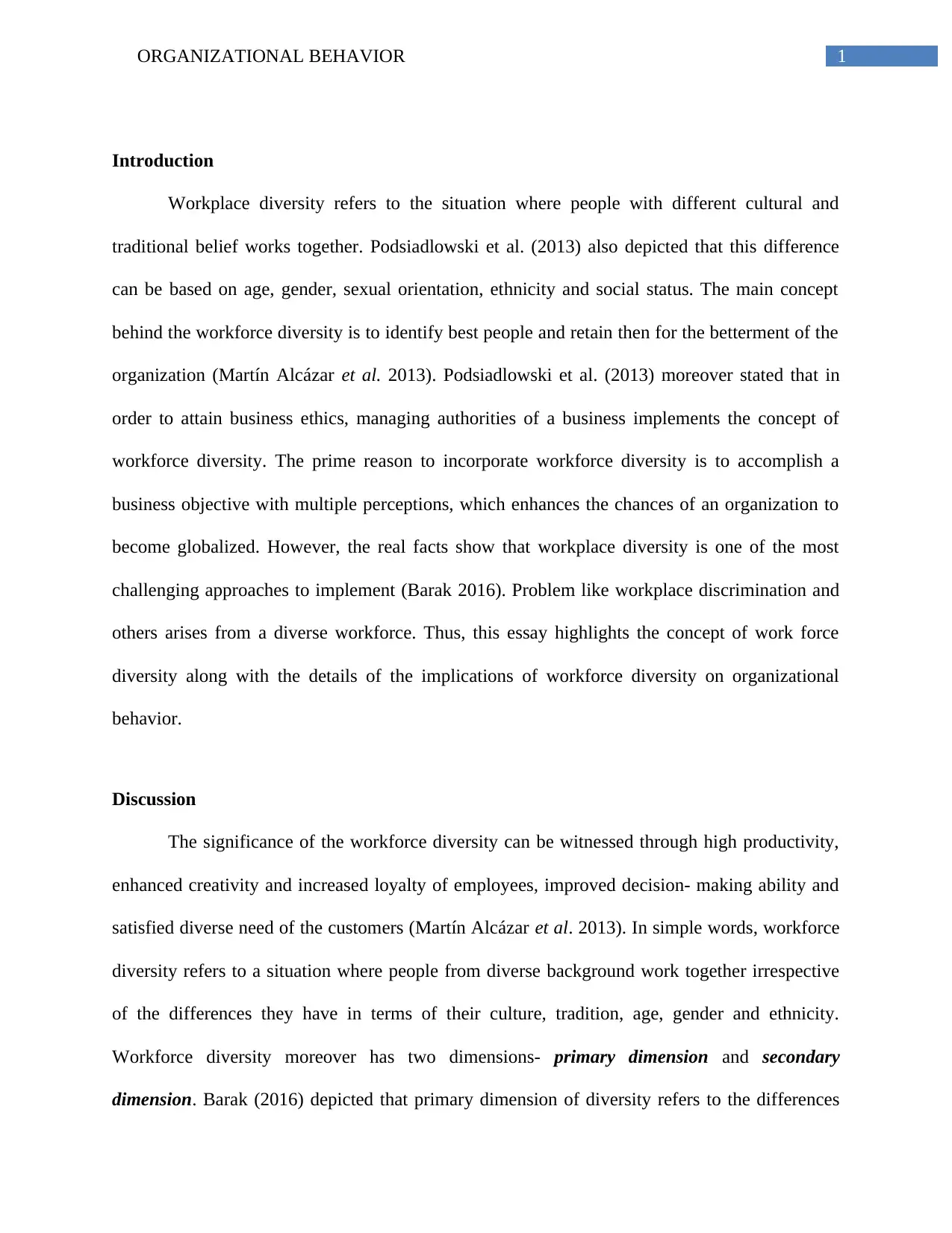
1ORGANIZATIONAL BEHAVIOR
Introduction
Workplace diversity refers to the situation where people with different cultural and
traditional belief works together. Podsiadlowski et al. (2013) also depicted that this difference
can be based on age, gender, sexual orientation, ethnicity and social status. The main concept
behind the workforce diversity is to identify best people and retain then for the betterment of the
organization (Martín Alcázar et al. 2013). Podsiadlowski et al. (2013) moreover stated that in
order to attain business ethics, managing authorities of a business implements the concept of
workforce diversity. The prime reason to incorporate workforce diversity is to accomplish a
business objective with multiple perceptions, which enhances the chances of an organization to
become globalized. However, the real facts show that workplace diversity is one of the most
challenging approaches to implement (Barak 2016). Problem like workplace discrimination and
others arises from a diverse workforce. Thus, this essay highlights the concept of work force
diversity along with the details of the implications of workforce diversity on organizational
behavior.
Discussion
The significance of the workforce diversity can be witnessed through high productivity,
enhanced creativity and increased loyalty of employees, improved decision- making ability and
satisfied diverse need of the customers (Martín Alcázar et al. 2013). In simple words, workforce
diversity refers to a situation where people from diverse background work together irrespective
of the differences they have in terms of their culture, tradition, age, gender and ethnicity.
Workforce diversity moreover has two dimensions- primary dimension and secondary
dimension. Barak (2016) depicted that primary dimension of diversity refers to the differences
Introduction
Workplace diversity refers to the situation where people with different cultural and
traditional belief works together. Podsiadlowski et al. (2013) also depicted that this difference
can be based on age, gender, sexual orientation, ethnicity and social status. The main concept
behind the workforce diversity is to identify best people and retain then for the betterment of the
organization (Martín Alcázar et al. 2013). Podsiadlowski et al. (2013) moreover stated that in
order to attain business ethics, managing authorities of a business implements the concept of
workforce diversity. The prime reason to incorporate workforce diversity is to accomplish a
business objective with multiple perceptions, which enhances the chances of an organization to
become globalized. However, the real facts show that workplace diversity is one of the most
challenging approaches to implement (Barak 2016). Problem like workplace discrimination and
others arises from a diverse workforce. Thus, this essay highlights the concept of work force
diversity along with the details of the implications of workforce diversity on organizational
behavior.
Discussion
The significance of the workforce diversity can be witnessed through high productivity,
enhanced creativity and increased loyalty of employees, improved decision- making ability and
satisfied diverse need of the customers (Martín Alcázar et al. 2013). In simple words, workforce
diversity refers to a situation where people from diverse background work together irrespective
of the differences they have in terms of their culture, tradition, age, gender and ethnicity.
Workforce diversity moreover has two dimensions- primary dimension and secondary
dimension. Barak (2016) depicted that primary dimension of diversity refers to the differences
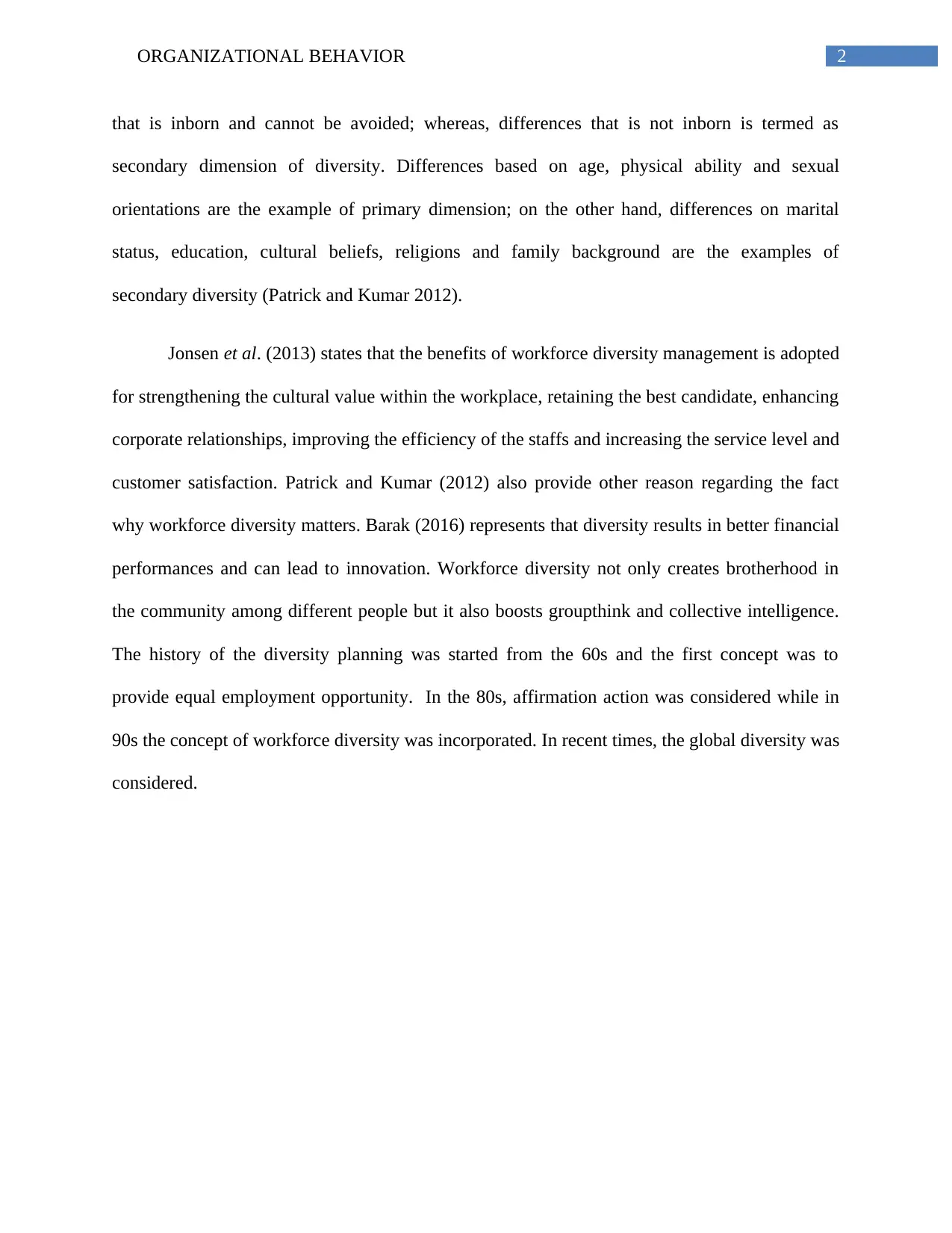
2ORGANIZATIONAL BEHAVIOR
that is inborn and cannot be avoided; whereas, differences that is not inborn is termed as
secondary dimension of diversity. Differences based on age, physical ability and sexual
orientations are the example of primary dimension; on the other hand, differences on marital
status, education, cultural beliefs, religions and family background are the examples of
secondary diversity (Patrick and Kumar 2012).
Jonsen et al. (2013) states that the benefits of workforce diversity management is adopted
for strengthening the cultural value within the workplace, retaining the best candidate, enhancing
corporate relationships, improving the efficiency of the staffs and increasing the service level and
customer satisfaction. Patrick and Kumar (2012) also provide other reason regarding the fact
why workforce diversity matters. Barak (2016) represents that diversity results in better financial
performances and can lead to innovation. Workforce diversity not only creates brotherhood in
the community among different people but it also boosts groupthink and collective intelligence.
The history of the diversity planning was started from the 60s and the first concept was to
provide equal employment opportunity. In the 80s, affirmation action was considered while in
90s the concept of workforce diversity was incorporated. In recent times, the global diversity was
considered.
that is inborn and cannot be avoided; whereas, differences that is not inborn is termed as
secondary dimension of diversity. Differences based on age, physical ability and sexual
orientations are the example of primary dimension; on the other hand, differences on marital
status, education, cultural beliefs, religions and family background are the examples of
secondary diversity (Patrick and Kumar 2012).
Jonsen et al. (2013) states that the benefits of workforce diversity management is adopted
for strengthening the cultural value within the workplace, retaining the best candidate, enhancing
corporate relationships, improving the efficiency of the staffs and increasing the service level and
customer satisfaction. Patrick and Kumar (2012) also provide other reason regarding the fact
why workforce diversity matters. Barak (2016) represents that diversity results in better financial
performances and can lead to innovation. Workforce diversity not only creates brotherhood in
the community among different people but it also boosts groupthink and collective intelligence.
The history of the diversity planning was started from the 60s and the first concept was to
provide equal employment opportunity. In the 80s, affirmation action was considered while in
90s the concept of workforce diversity was incorporated. In recent times, the global diversity was
considered.
⊘ This is a preview!⊘
Do you want full access?
Subscribe today to unlock all pages.

Trusted by 1+ million students worldwide
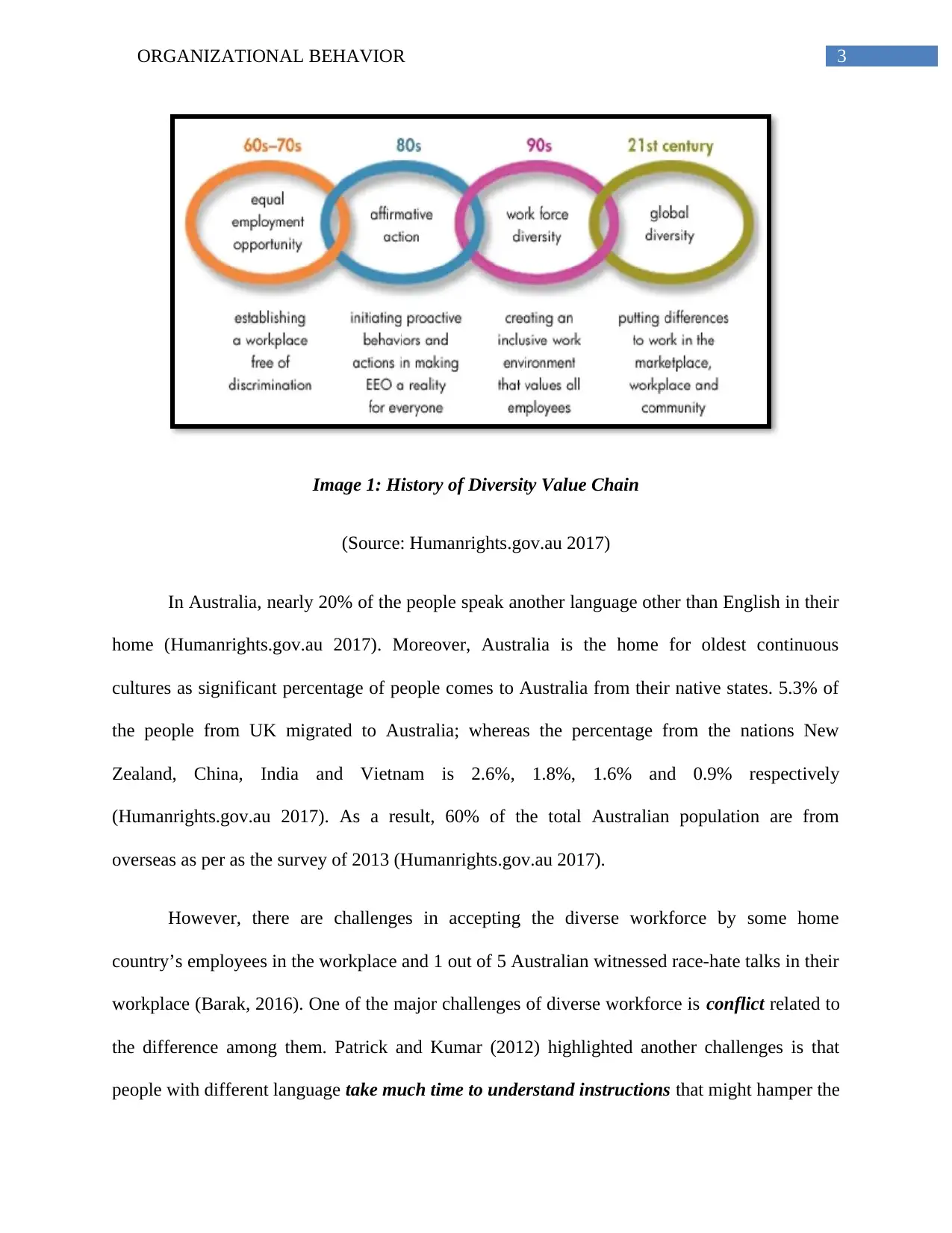
3ORGANIZATIONAL BEHAVIOR
Image 1: History of Diversity Value Chain
(Source: Humanrights.gov.au 2017)
In Australia, nearly 20% of the people speak another language other than English in their
home (Humanrights.gov.au 2017). Moreover, Australia is the home for oldest continuous
cultures as significant percentage of people comes to Australia from their native states. 5.3% of
the people from UK migrated to Australia; whereas the percentage from the nations New
Zealand, China, India and Vietnam is 2.6%, 1.8%, 1.6% and 0.9% respectively
(Humanrights.gov.au 2017). As a result, 60% of the total Australian population are from
overseas as per as the survey of 2013 (Humanrights.gov.au 2017).
However, there are challenges in accepting the diverse workforce by some home
country’s employees in the workplace and 1 out of 5 Australian witnessed race-hate talks in their
workplace (Barak, 2016). One of the major challenges of diverse workforce is conflict related to
the difference among them. Patrick and Kumar (2012) highlighted another challenges is that
people with different language take much time to understand instructions that might hamper the
Image 1: History of Diversity Value Chain
(Source: Humanrights.gov.au 2017)
In Australia, nearly 20% of the people speak another language other than English in their
home (Humanrights.gov.au 2017). Moreover, Australia is the home for oldest continuous
cultures as significant percentage of people comes to Australia from their native states. 5.3% of
the people from UK migrated to Australia; whereas the percentage from the nations New
Zealand, China, India and Vietnam is 2.6%, 1.8%, 1.6% and 0.9% respectively
(Humanrights.gov.au 2017). As a result, 60% of the total Australian population are from
overseas as per as the survey of 2013 (Humanrights.gov.au 2017).
However, there are challenges in accepting the diverse workforce by some home
country’s employees in the workplace and 1 out of 5 Australian witnessed race-hate talks in their
workplace (Barak, 2016). One of the major challenges of diverse workforce is conflict related to
the difference among them. Patrick and Kumar (2012) highlighted another challenges is that
people with different language take much time to understand instructions that might hamper the
Paraphrase This Document
Need a fresh take? Get an instant paraphrase of this document with our AI Paraphraser
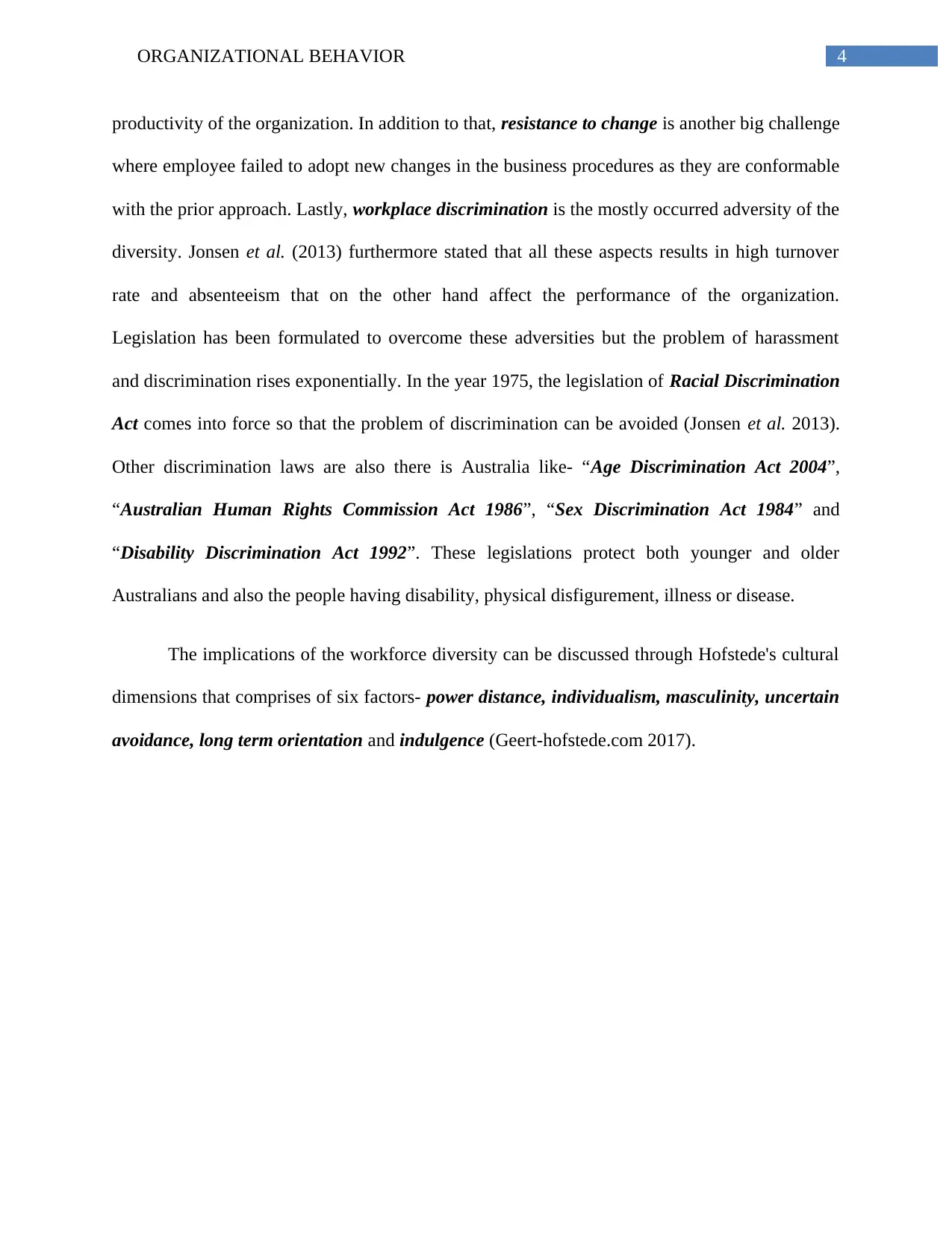
4ORGANIZATIONAL BEHAVIOR
productivity of the organization. In addition to that, resistance to change is another big challenge
where employee failed to adopt new changes in the business procedures as they are conformable
with the prior approach. Lastly, workplace discrimination is the mostly occurred adversity of the
diversity. Jonsen et al. (2013) furthermore stated that all these aspects results in high turnover
rate and absenteeism that on the other hand affect the performance of the organization.
Legislation has been formulated to overcome these adversities but the problem of harassment
and discrimination rises exponentially. In the year 1975, the legislation of Racial Discrimination
Act comes into force so that the problem of discrimination can be avoided (Jonsen et al. 2013).
Other discrimination laws are also there is Australia like- “Age Discrimination Act 2004”,
“Australian Human Rights Commission Act 1986”, “Sex Discrimination Act 1984” and
“Disability Discrimination Act 1992”. These legislations protect both younger and older
Australians and also the people having disability, physical disfigurement, illness or disease.
The implications of the workforce diversity can be discussed through Hofstede's cultural
dimensions that comprises of six factors- power distance, individualism, masculinity, uncertain
avoidance, long term orientation and indulgence (Geert-hofstede.com 2017).
productivity of the organization. In addition to that, resistance to change is another big challenge
where employee failed to adopt new changes in the business procedures as they are conformable
with the prior approach. Lastly, workplace discrimination is the mostly occurred adversity of the
diversity. Jonsen et al. (2013) furthermore stated that all these aspects results in high turnover
rate and absenteeism that on the other hand affect the performance of the organization.
Legislation has been formulated to overcome these adversities but the problem of harassment
and discrimination rises exponentially. In the year 1975, the legislation of Racial Discrimination
Act comes into force so that the problem of discrimination can be avoided (Jonsen et al. 2013).
Other discrimination laws are also there is Australia like- “Age Discrimination Act 2004”,
“Australian Human Rights Commission Act 1986”, “Sex Discrimination Act 1984” and
“Disability Discrimination Act 1992”. These legislations protect both younger and older
Australians and also the people having disability, physical disfigurement, illness or disease.
The implications of the workforce diversity can be discussed through Hofstede's cultural
dimensions that comprises of six factors- power distance, individualism, masculinity, uncertain
avoidance, long term orientation and indulgence (Geert-hofstede.com 2017).
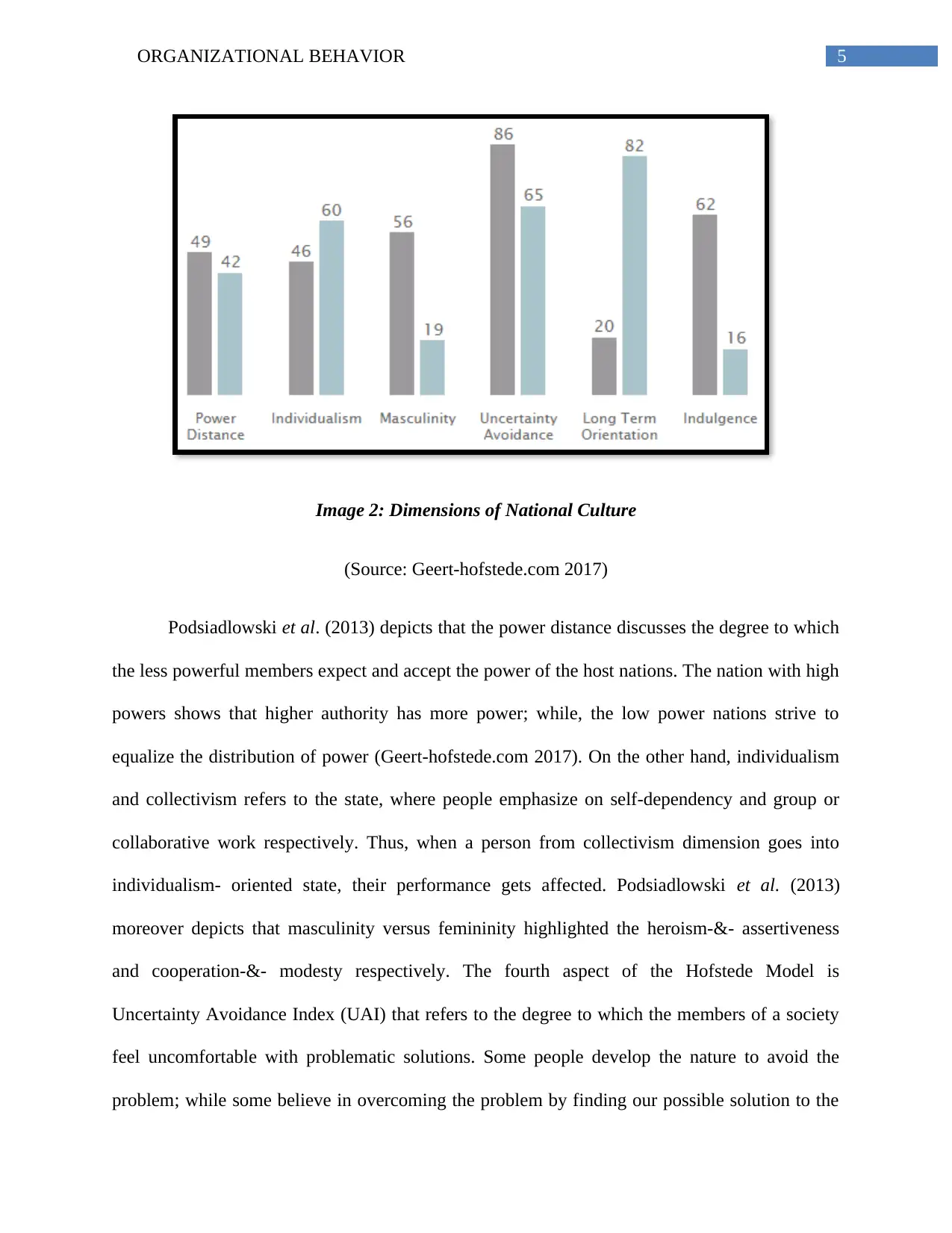
5ORGANIZATIONAL BEHAVIOR
Image 2: Dimensions of National Culture
(Source: Geert-hofstede.com 2017)
Podsiadlowski et al. (2013) depicts that the power distance discusses the degree to which
the less powerful members expect and accept the power of the host nations. The nation with high
powers shows that higher authority has more power; while, the low power nations strive to
equalize the distribution of power (Geert-hofstede.com 2017). On the other hand, individualism
and collectivism refers to the state, where people emphasize on self-dependency and group or
collaborative work respectively. Thus, when a person from collectivism dimension goes into
individualism- oriented state, their performance gets affected. Podsiadlowski et al. (2013)
moreover depicts that masculinity versus femininity highlighted the heroism-&- assertiveness
and cooperation-&- modesty respectively. The fourth aspect of the Hofstede Model is
Uncertainty Avoidance Index (UAI) that refers to the degree to which the members of a society
feel uncomfortable with problematic solutions. Some people develop the nature to avoid the
problem; while some believe in overcoming the problem by finding our possible solution to the
Image 2: Dimensions of National Culture
(Source: Geert-hofstede.com 2017)
Podsiadlowski et al. (2013) depicts that the power distance discusses the degree to which
the less powerful members expect and accept the power of the host nations. The nation with high
powers shows that higher authority has more power; while, the low power nations strive to
equalize the distribution of power (Geert-hofstede.com 2017). On the other hand, individualism
and collectivism refers to the state, where people emphasize on self-dependency and group or
collaborative work respectively. Thus, when a person from collectivism dimension goes into
individualism- oriented state, their performance gets affected. Podsiadlowski et al. (2013)
moreover depicts that masculinity versus femininity highlighted the heroism-&- assertiveness
and cooperation-&- modesty respectively. The fourth aspect of the Hofstede Model is
Uncertainty Avoidance Index (UAI) that refers to the degree to which the members of a society
feel uncomfortable with problematic solutions. Some people develop the nature to avoid the
problem; while some believe in overcoming the problem by finding our possible solution to the
⊘ This is a preview!⊘
Do you want full access?
Subscribe today to unlock all pages.

Trusted by 1+ million students worldwide
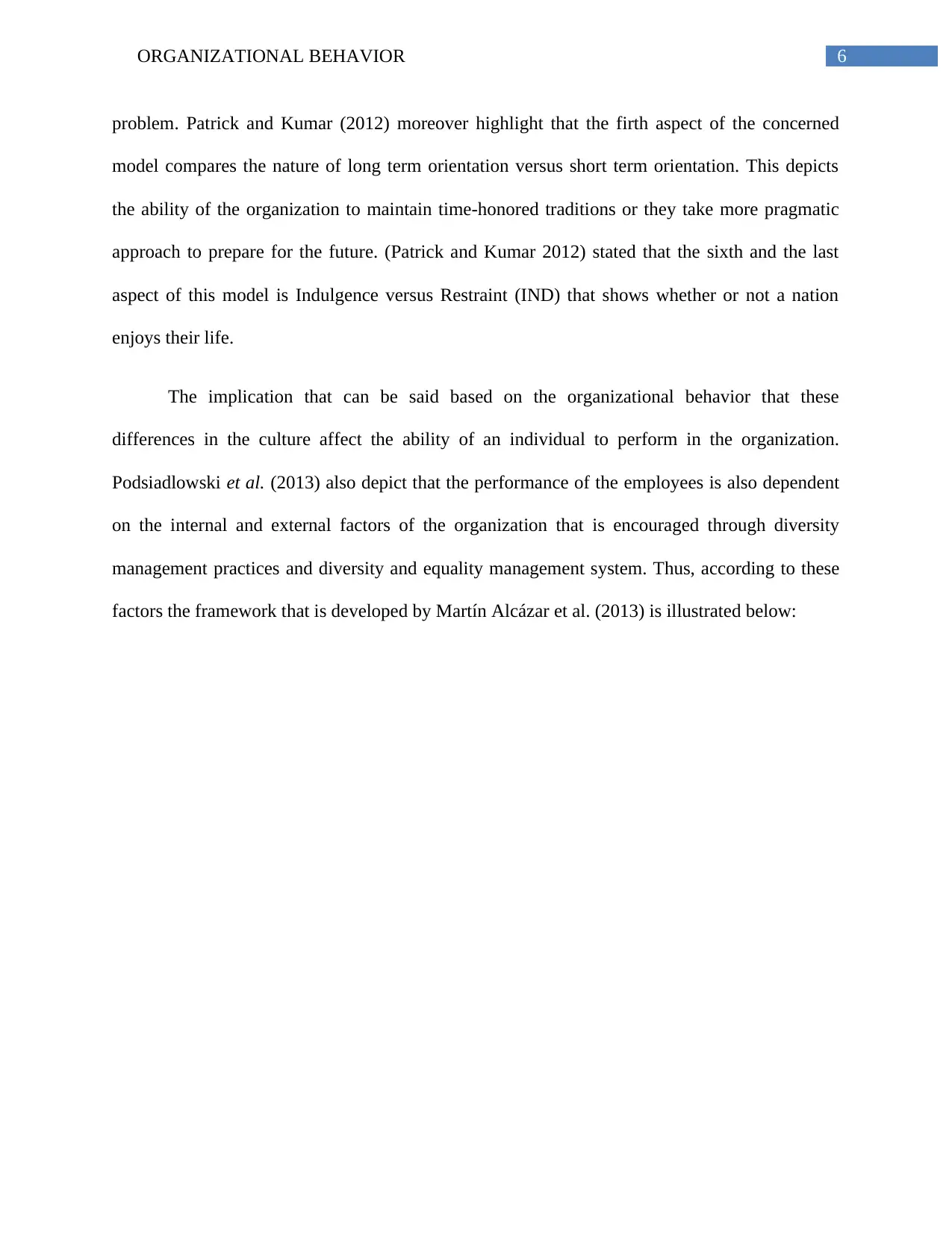
6ORGANIZATIONAL BEHAVIOR
problem. Patrick and Kumar (2012) moreover highlight that the firth aspect of the concerned
model compares the nature of long term orientation versus short term orientation. This depicts
the ability of the organization to maintain time-honored traditions or they take more pragmatic
approach to prepare for the future. (Patrick and Kumar 2012) stated that the sixth and the last
aspect of this model is Indulgence versus Restraint (IND) that shows whether or not a nation
enjoys their life.
The implication that can be said based on the organizational behavior that these
differences in the culture affect the ability of an individual to perform in the organization.
Podsiadlowski et al. (2013) also depict that the performance of the employees is also dependent
on the internal and external factors of the organization that is encouraged through diversity
management practices and diversity and equality management system. Thus, according to these
factors the framework that is developed by Martín Alcázar et al. (2013) is illustrated below:
problem. Patrick and Kumar (2012) moreover highlight that the firth aspect of the concerned
model compares the nature of long term orientation versus short term orientation. This depicts
the ability of the organization to maintain time-honored traditions or they take more pragmatic
approach to prepare for the future. (Patrick and Kumar 2012) stated that the sixth and the last
aspect of this model is Indulgence versus Restraint (IND) that shows whether or not a nation
enjoys their life.
The implication that can be said based on the organizational behavior that these
differences in the culture affect the ability of an individual to perform in the organization.
Podsiadlowski et al. (2013) also depict that the performance of the employees is also dependent
on the internal and external factors of the organization that is encouraged through diversity
management practices and diversity and equality management system. Thus, according to these
factors the framework that is developed by Martín Alcázar et al. (2013) is illustrated below:
Paraphrase This Document
Need a fresh take? Get an instant paraphrase of this document with our AI Paraphraser
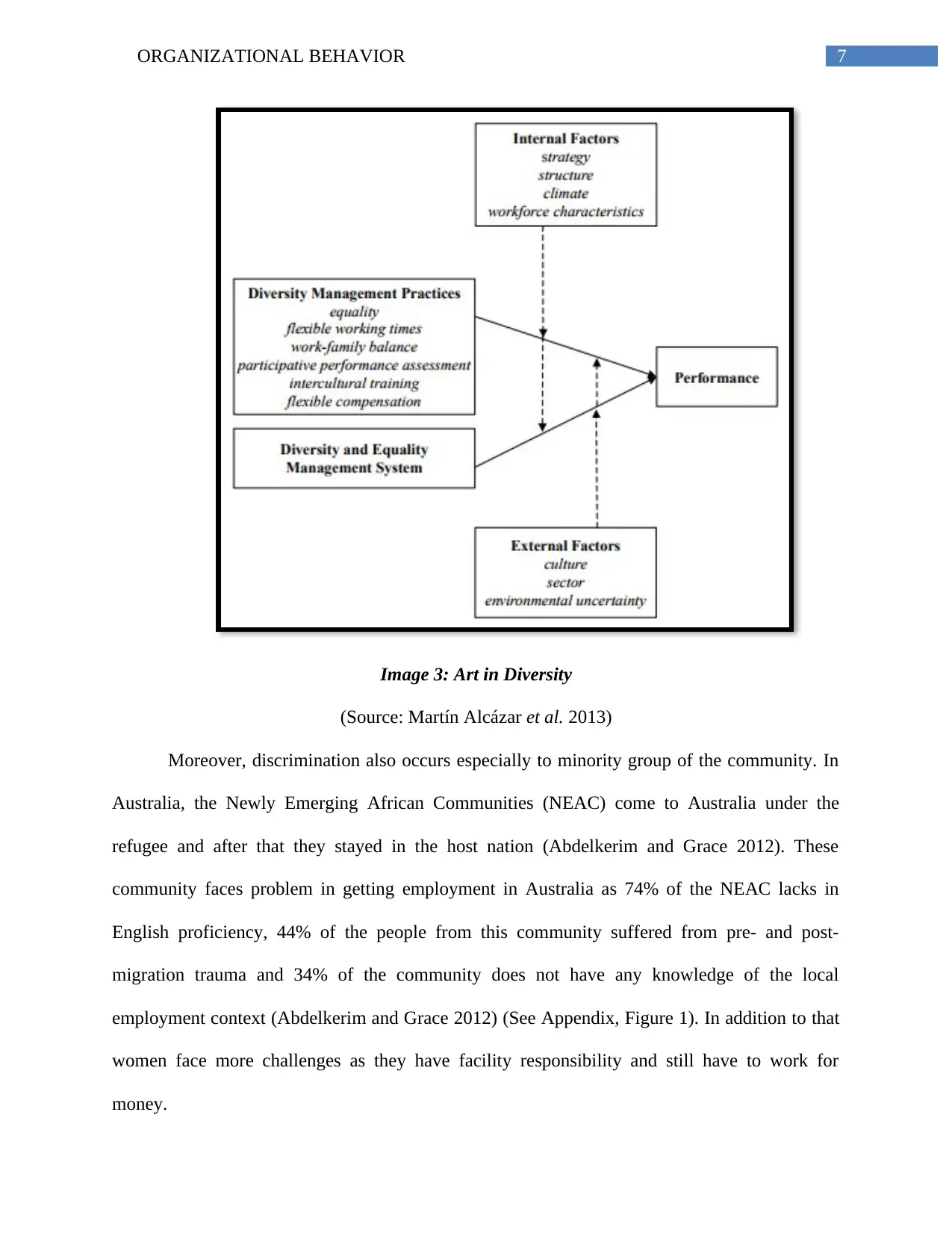
7ORGANIZATIONAL BEHAVIOR
Image 3: Art in Diversity
(Source: Martín Alcázar et al. 2013)
Moreover, discrimination also occurs especially to minority group of the community. In
Australia, the Newly Emerging African Communities (NEAC) come to Australia under the
refugee and after that they stayed in the host nation (Abdelkerim and Grace 2012). These
community faces problem in getting employment in Australia as 74% of the NEAC lacks in
English proficiency, 44% of the people from this community suffered from pre- and post-
migration trauma and 34% of the community does not have any knowledge of the local
employment context (Abdelkerim and Grace 2012) (See Appendix, Figure 1). In addition to that
women face more challenges as they have facility responsibility and still have to work for
money.
Image 3: Art in Diversity
(Source: Martín Alcázar et al. 2013)
Moreover, discrimination also occurs especially to minority group of the community. In
Australia, the Newly Emerging African Communities (NEAC) come to Australia under the
refugee and after that they stayed in the host nation (Abdelkerim and Grace 2012). These
community faces problem in getting employment in Australia as 74% of the NEAC lacks in
English proficiency, 44% of the people from this community suffered from pre- and post-
migration trauma and 34% of the community does not have any knowledge of the local
employment context (Abdelkerim and Grace 2012) (See Appendix, Figure 1). In addition to that
women face more challenges as they have facility responsibility and still have to work for
money.
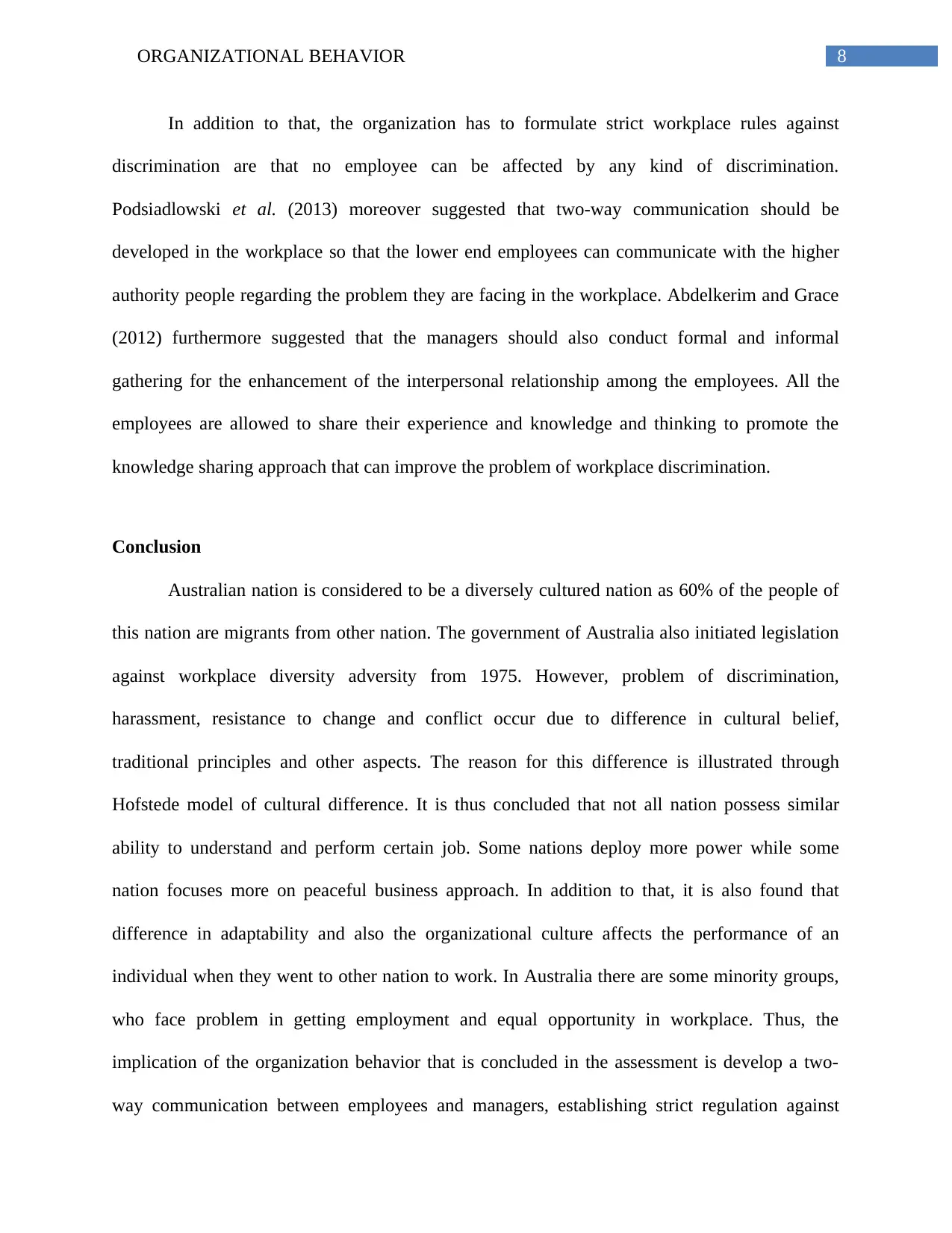
8ORGANIZATIONAL BEHAVIOR
In addition to that, the organization has to formulate strict workplace rules against
discrimination are that no employee can be affected by any kind of discrimination.
Podsiadlowski et al. (2013) moreover suggested that two-way communication should be
developed in the workplace so that the lower end employees can communicate with the higher
authority people regarding the problem they are facing in the workplace. Abdelkerim and Grace
(2012) furthermore suggested that the managers should also conduct formal and informal
gathering for the enhancement of the interpersonal relationship among the employees. All the
employees are allowed to share their experience and knowledge and thinking to promote the
knowledge sharing approach that can improve the problem of workplace discrimination.
Conclusion
Australian nation is considered to be a diversely cultured nation as 60% of the people of
this nation are migrants from other nation. The government of Australia also initiated legislation
against workplace diversity adversity from 1975. However, problem of discrimination,
harassment, resistance to change and conflict occur due to difference in cultural belief,
traditional principles and other aspects. The reason for this difference is illustrated through
Hofstede model of cultural difference. It is thus concluded that not all nation possess similar
ability to understand and perform certain job. Some nations deploy more power while some
nation focuses more on peaceful business approach. In addition to that, it is also found that
difference in adaptability and also the organizational culture affects the performance of an
individual when they went to other nation to work. In Australia there are some minority groups,
who face problem in getting employment and equal opportunity in workplace. Thus, the
implication of the organization behavior that is concluded in the assessment is develop a two-
way communication between employees and managers, establishing strict regulation against
In addition to that, the organization has to formulate strict workplace rules against
discrimination are that no employee can be affected by any kind of discrimination.
Podsiadlowski et al. (2013) moreover suggested that two-way communication should be
developed in the workplace so that the lower end employees can communicate with the higher
authority people regarding the problem they are facing in the workplace. Abdelkerim and Grace
(2012) furthermore suggested that the managers should also conduct formal and informal
gathering for the enhancement of the interpersonal relationship among the employees. All the
employees are allowed to share their experience and knowledge and thinking to promote the
knowledge sharing approach that can improve the problem of workplace discrimination.
Conclusion
Australian nation is considered to be a diversely cultured nation as 60% of the people of
this nation are migrants from other nation. The government of Australia also initiated legislation
against workplace diversity adversity from 1975. However, problem of discrimination,
harassment, resistance to change and conflict occur due to difference in cultural belief,
traditional principles and other aspects. The reason for this difference is illustrated through
Hofstede model of cultural difference. It is thus concluded that not all nation possess similar
ability to understand and perform certain job. Some nations deploy more power while some
nation focuses more on peaceful business approach. In addition to that, it is also found that
difference in adaptability and also the organizational culture affects the performance of an
individual when they went to other nation to work. In Australia there are some minority groups,
who face problem in getting employment and equal opportunity in workplace. Thus, the
implication of the organization behavior that is concluded in the assessment is develop a two-
way communication between employees and managers, establishing strict regulation against
⊘ This is a preview!⊘
Do you want full access?
Subscribe today to unlock all pages.

Trusted by 1+ million students worldwide
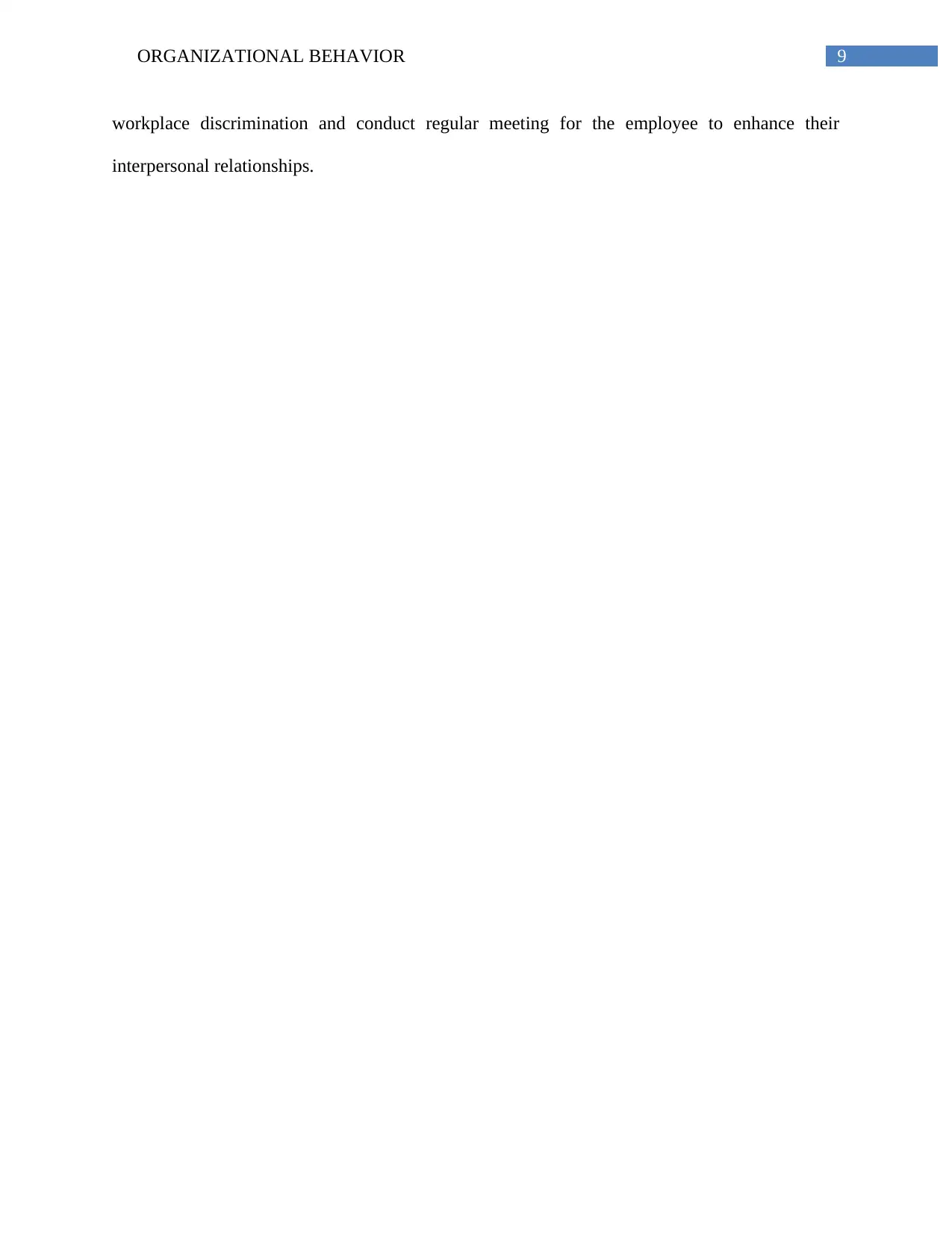
9ORGANIZATIONAL BEHAVIOR
workplace discrimination and conduct regular meeting for the employee to enhance their
interpersonal relationships.
workplace discrimination and conduct regular meeting for the employee to enhance their
interpersonal relationships.
Paraphrase This Document
Need a fresh take? Get an instant paraphrase of this document with our AI Paraphraser
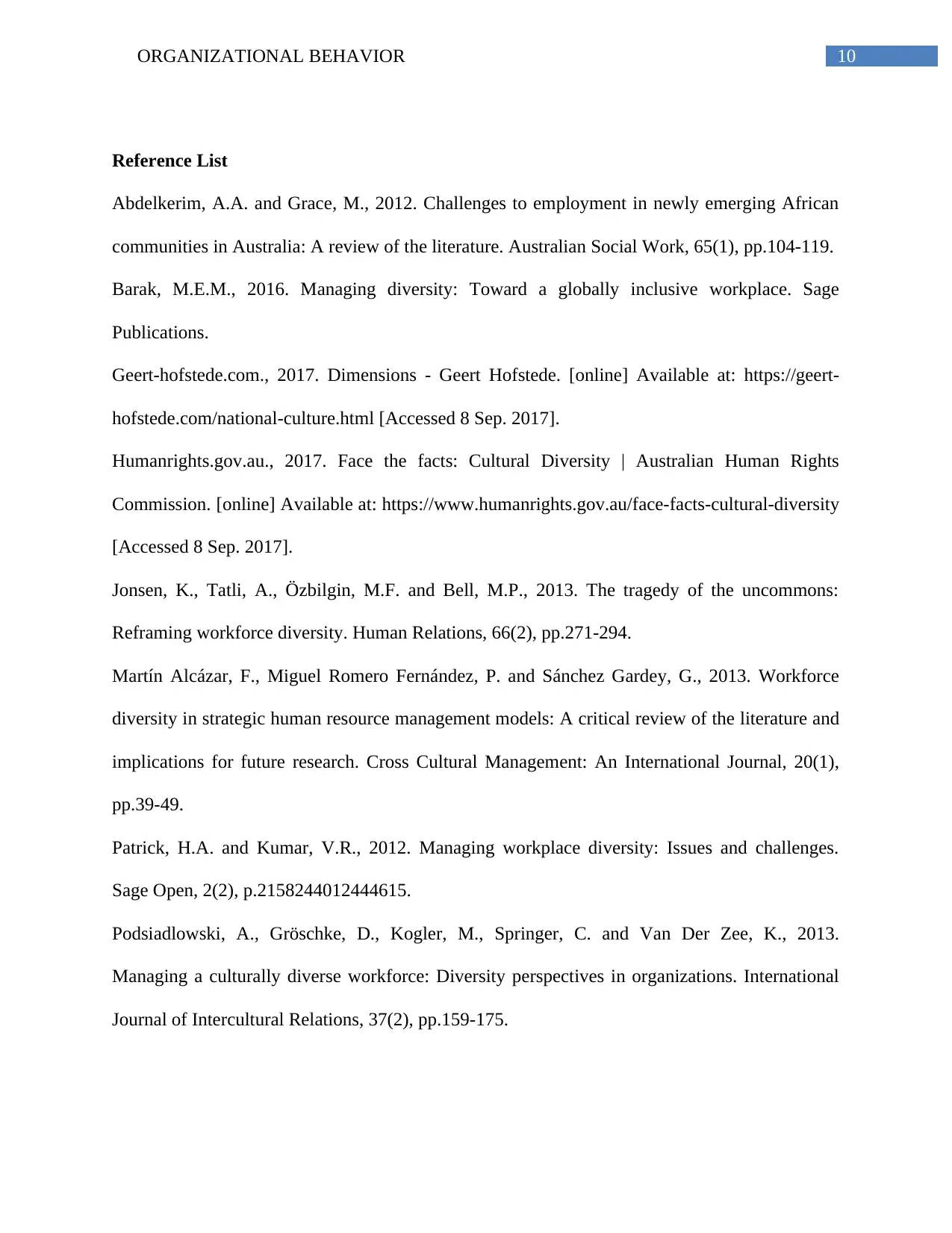
10ORGANIZATIONAL BEHAVIOR
Reference List
Abdelkerim, A.A. and Grace, M., 2012. Challenges to employment in newly emerging African
communities in Australia: A review of the literature. Australian Social Work, 65(1), pp.104-119.
Barak, M.E.M., 2016. Managing diversity: Toward a globally inclusive workplace. Sage
Publications.
Geert-hofstede.com., 2017. Dimensions - Geert Hofstede. [online] Available at: https://geert-
hofstede.com/national-culture.html [Accessed 8 Sep. 2017].
Humanrights.gov.au., 2017. Face the facts: Cultural Diversity | Australian Human Rights
Commission. [online] Available at: https://www.humanrights.gov.au/face-facts-cultural-diversity
[Accessed 8 Sep. 2017].
Jonsen, K., Tatli, A., Özbilgin, M.F. and Bell, M.P., 2013. The tragedy of the uncommons:
Reframing workforce diversity. Human Relations, 66(2), pp.271-294.
Martín Alcázar, F., Miguel Romero Fernández, P. and Sánchez Gardey, G., 2013. Workforce
diversity in strategic human resource management models: A critical review of the literature and
implications for future research. Cross Cultural Management: An International Journal, 20(1),
pp.39-49.
Patrick, H.A. and Kumar, V.R., 2012. Managing workplace diversity: Issues and challenges.
Sage Open, 2(2), p.2158244012444615.
Podsiadlowski, A., Gröschke, D., Kogler, M., Springer, C. and Van Der Zee, K., 2013.
Managing a culturally diverse workforce: Diversity perspectives in organizations. International
Journal of Intercultural Relations, 37(2), pp.159-175.
Reference List
Abdelkerim, A.A. and Grace, M., 2012. Challenges to employment in newly emerging African
communities in Australia: A review of the literature. Australian Social Work, 65(1), pp.104-119.
Barak, M.E.M., 2016. Managing diversity: Toward a globally inclusive workplace. Sage
Publications.
Geert-hofstede.com., 2017. Dimensions - Geert Hofstede. [online] Available at: https://geert-
hofstede.com/national-culture.html [Accessed 8 Sep. 2017].
Humanrights.gov.au., 2017. Face the facts: Cultural Diversity | Australian Human Rights
Commission. [online] Available at: https://www.humanrights.gov.au/face-facts-cultural-diversity
[Accessed 8 Sep. 2017].
Jonsen, K., Tatli, A., Özbilgin, M.F. and Bell, M.P., 2013. The tragedy of the uncommons:
Reframing workforce diversity. Human Relations, 66(2), pp.271-294.
Martín Alcázar, F., Miguel Romero Fernández, P. and Sánchez Gardey, G., 2013. Workforce
diversity in strategic human resource management models: A critical review of the literature and
implications for future research. Cross Cultural Management: An International Journal, 20(1),
pp.39-49.
Patrick, H.A. and Kumar, V.R., 2012. Managing workplace diversity: Issues and challenges.
Sage Open, 2(2), p.2158244012444615.
Podsiadlowski, A., Gröschke, D., Kogler, M., Springer, C. and Van Der Zee, K., 2013.
Managing a culturally diverse workforce: Diversity perspectives in organizations. International
Journal of Intercultural Relations, 37(2), pp.159-175.
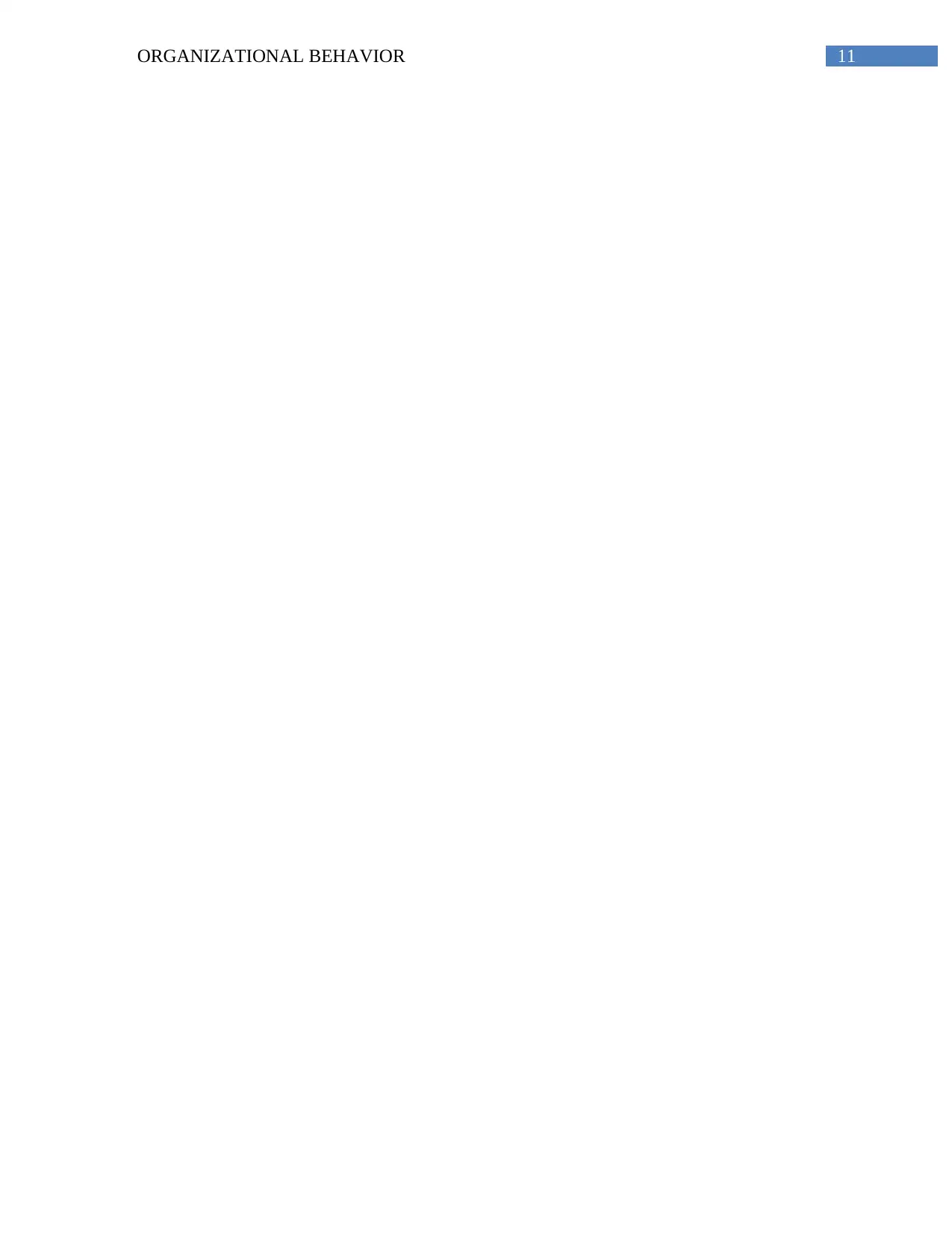
11ORGANIZATIONAL BEHAVIOR
⊘ This is a preview!⊘
Do you want full access?
Subscribe today to unlock all pages.

Trusted by 1+ million students worldwide
1 out of 12
Related Documents
Your All-in-One AI-Powered Toolkit for Academic Success.
+13062052269
info@desklib.com
Available 24*7 on WhatsApp / Email
![[object Object]](/_next/static/media/star-bottom.7253800d.svg)
Unlock your academic potential
Copyright © 2020–2025 A2Z Services. All Rights Reserved. Developed and managed by ZUCOL.





